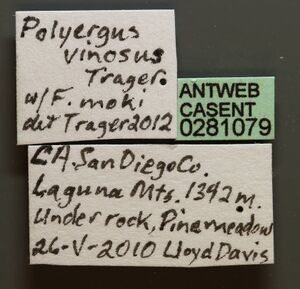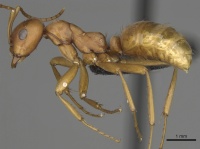Polyergus vinosus
| Polyergus vinosus | |
|---|---|

| |
| Scientific classification | |
| Kingdom: | Animalia |
| Phylum: | Arthropoda |
| Class: | Insecta |
| Order: | Hymenoptera |
| Family: | Formicidae |
| Subfamily: | Formicinae |
| Tribe: | Formicini |
| Genus: | Polyergus |
| Species group: | rufescens-breviceps |
| Species: | P. vinosus |
| Binomial name | |
| Polyergus vinosus Trager, 2013 | |
A southwestern North American species found in a number of coastal and near-coastal habitats. Its biology is relatively poorly known but it appears it exclusively raids colonies of Formica moki.
| At a Glance | • Dulotic |
Identification
Keys including this Species
Distribution
This species is endemic to the Californian vegetation zone of southern California and northern Baja California, Mexico, and is also found on Santa Cruz Island, California.
Latitudinal Distribution Pattern
Latitudinal Range: 36.0577° to 32.31694444°.
| North Temperate |
North Subtropical |
Tropical | South Subtropical |
South Temperate |
- Source: AntMaps
Distribution based on Regional Taxon Lists
Nearctic Region: United States (type locality).
Neotropical Region: Mexico.
Distribution based on AntMaps
Distribution based on AntWeb specimens
Check data from AntWeb
Countries Occupied
| Number of countries occupied by this species based on AntWiki Regional Taxon Lists. In general, fewer countries occupied indicates a narrower range, while more countries indicates a more widespread species. |

|
Estimated Abundance
| Relative abundance based on number of AntMaps records per species (this species within the purple bar). Fewer records (to the left) indicates a less abundant/encountered species while more records (to the right) indicates more abundant/encountered species. |

|
Biology
Polyergus vinosus is a species of mature chaparral, coast live oak woodland and savanna, rocky wooded canyons and oak-gray pine woodlands of the southern California coast hills. As far as known, its exclusive host species is Formica moki (Trager, 2013; de la Mora et al., 2021), and the nests have the host species’ usual cryptic placement among rocks, often near streams or along wet-weather drainages, and sometimes with a lightly thatched superstructure. Only a few raids have been observed, but from unpublished observations by Les Greenberg (U. C. Riverside, pers. comm.) and Geoff Trager (then a student at UC Santa Barbara, pers. comm.), we know that the raids take place in early to mid summer, in the latter half of the afternoon. The raiding season may begin and end earlier than that of species from colder, summer-rainy climates.
Flight Period
| X | |||||||||||
| Jan | Feb | Mar | Apr | May | Jun | Jul | Aug | Sep | Oct | Nov | Dec |
Source: antkeeping.info.
- Check details at Worldwide Ant Nuptial Flights Data, AntNupTracker and AntKeeping.
- Explore: Show all Flight Month data or Search these data. See also a list of all data tables or learn how data is managed.
Castes
Worker
Images from AntWeb
   
| |
| Worker. Specimen code casent0281079. Photographer Shannon Hartman, uploaded by California Academy of Sciences. | Owned by CAS, San Francisco, CA, USA. |
   
| |
| Worker. Specimen code casent0281082. Photographer Shannon Hartman, uploaded by California Academy of Sciences. | Owned by CAS, San Francisco, CA, USA. |
Queen
Images from AntWeb
   
| |
| Queen (alate/dealate). Specimen code casent0281080. Photographer Shannon Hartman, uploaded by California Academy of Sciences. | Owned by CAS, San Francisco, CA, USA. |
Male
Images from AntWeb
     
| |
| Male (alate). Specimen code casent0281081. Photographer Shannon Hartman, uploaded by California Academy of Sciences. | Owned by CAS, San Francisco, CA, USA. |
Nomenclature
The following information is derived from Barry Bolton's Online Catalogue of the Ants of the World.
- vinosus. Polyergus vinosus Trager, 2013: 520, figs. 18-20 (w.q.m.) U.S.A.
Unless otherwise noted the text for the remainder of this section is reported from the publication that includes the original description.
Type Material
- Holotype, worker, Millard Canyon, San Gabriel Mts., California, United States, Los Angeles County Museum of Natural History.
- Paratype, worker (one possibly an ergatoid), 2 queens, 1 male, Millard Canyon, San Gabriel Mts., California, United States, Los Angeles County Museum of Natural History.
Description
Worker
Holotype HL 1.39, HW 1.34, SL 1.34, ½ VeM 0, ½ PnM 3, WL 2.16, GL 1.93, HFL 1.72, CI 96, SI 100, HFI 128, FSI 128, LI 3.55, TL 5.48.
Paratypes (N=4) HL 1.39–1.64 (1.51), HW 1.34–1.60 (1.46), SL 1.32–1.40 (1.37), ½ VeM 0, ½ PnM 3–6 (3.80), WL 2.16–2.40 (2.27), GL 1.64–2.44 (2.02), HFL 1.72–1.95 (1.83), CI 95–98 (97), SI 88–100 (94), HFI 122–128 (125), FSI 128–139 (134), LI 3.55–4.04 (3.78), TL 5.48–6.48 (5.81).
(N=36) HL 1.23–1.67 (1.43), HW 1.20–1.60 (1.40), SL 1.14–1.41 (1.27), ½ VeM 0–2 (0.11), ½ PnM 0–7 (3.43), WL 1.93–2.48 (2.18), GL 1.64–2.82 (2.14), HFL 1.55–2.00 (1.73), CI 95–103 (98), SI 80–100 (91), HFI 113–133 (124), FSI 128–142 (136), LI 3.23–4.15 (3.60), TL 4.26–6.97 (5.69).
Head truncate-ovate, its length usually slightly greater than breadth; scapes long for the breviceps species group (SI usually 85–95, never < 80), nearly reaching or even surpassing vertex corners, weakly clavate or gradually thickening in the apical third; pronotum with 0–6 (less often, up to 12, especially Santa Cruz Island population) dorsal macrosetae; mesonotum with profile weakly convex for most of its length, notably convex and “bulging” in the largest workers; propodeum subquadrate with a rounded angle; petiole sides rounded and converging dorsad, petiolar dorsum flat or even shallowly concave; first tergite densely pubescent; first tergite pilosity a relatively sparse 6–20 flexuous, mid-anterodorsal, suberect macrosetae and sometimes a few widely spaced ones in the posterior tergal half.
Head weakly shining; mesonotum weakly shining beneath fine gray pubescence; gaster weakly shining beneath fine gray pubescence.
Color mostly orange-red to wine red with scarcely any infuscation of gaster or appendages.
The most significant variation in this species is the greater pronotal pilosity of the Santa Cruz Island population, with ½ PnM 6–12, contrasting with 1–4 (rarely 5 or 6) on the mainland. Workers of Baja California are paler tan-orange in color (as in Fig. 6, possibly faded in preservation), and have a more rounded propodeal profile.
Etymology
“Vinosus” is Latin for red-wine-colored. Somewhat ironically, much of its habitat may be threatened by the conversion of its southern California oak woodland habitat to vineyards.
References
- Borowiec, M.L., Cover, S.P., Rabeling, C. 2021. The evolution of social parasitism in Formica ants revealed by a global phylogeny. Proceedings of the National Academy of Sciences 118, e2026029118 (doi:10.1073/pnas.2026029118).
- Cantone S. 2018. Winged Ants, The queen. Dichotomous key to genera of winged female ants in the World. The Wings of Ants: morphological and systematic relationships (self-published).
- de la Mora, A., Sankovitz, M., Purcell, J. 2020. Ants (Hymenoptera: Formicidae) as host and intruder: recent advances and future directions in the study of exploitative strategies. Myrmecological News 30: 53-71 (doi:10.25849/MYRMECOL.NEWS_030:053).
- Trager, J.C. 2013. Global revision of the dulotic ant genus Polyergus (Hymenoptera: Formicidae, Formicinae, Formicini). Zootaxa 3722, 501–548.
References based on Global Ant Biodiversity Informatics
- Des Lauriers J., and D. Ikeda. 2017. The ants (Hymenoptera: Formicidae) of the San Gabriel Mountains of Southern California, USA with an annotated list. In: Reynolds R. E. (Ed.) Desert Studies Symposium. California State University Desert Studies Consortium, 342 pp. Pages 264-277.
- Trager J. C. 2013. Global revision of the dulotic ant genus Polyergus (Hymenoptera: Formicidae, Formicinae, Formicini). Zootaxa 3722(4): 501-548.

